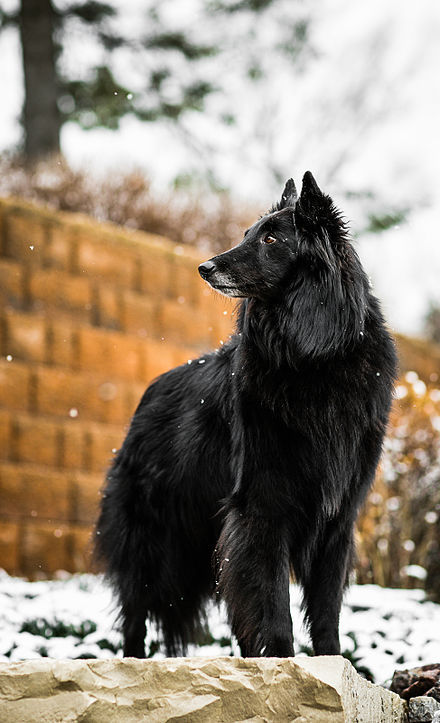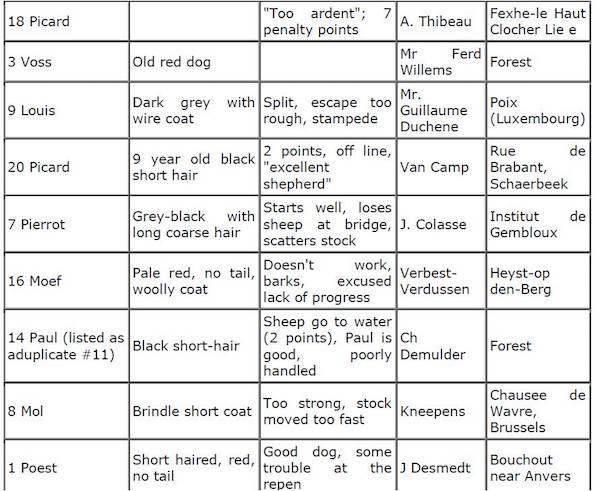
Before 1959, the Belgian Tervuren, Belgian Malinois, and Belgian Sheepdog were all registered by the AKC as Belgian Sheepdogs, and judged as one breed. Except for coat, they were thought to be so similar as to be one breed.
It was in 1959 that the three Sheepdogs were divided into three distinct breeds by the AKC, in some measure because the year before, a nucleus of Groenendael breeders (as the Belgian Sheepdog is known in Europe) vigorously protested that the other two Belgian Sheepdogs were so different from their own breed as to be not the same breed at all. In response, the AKC queried Belgian Sheepdog owners about inter-variety breeding and competition, and in July of ’59, AKC Board of Directors voted to separate the varieties into three unique breeds. Since Groenendael owners wanted to keep the name, “Belgian Sheepdog,” for their breed, the name “Belgian” was added to the Malinois and Tervuren breeds.
It wasn’t the first time that fanciers of the Belgian Sheepdog protested their individuality. In 1892, the Club du Chien de Bourg-en-Bresse petitioned the Societe Royale Saint-Hubert (the Belgian version of the AKC) to recognize the Belgian Sheepdog as its own separate and unique breed.
They were denied.
Less than ten years later (during which time the breed became more firmly established), the Societe Royale Saint-Hubert acknowledged that Belgian Sheepdog was indeed a unique breed.
Today, the AKC and the New Zealand Kennel Club recognize all four Belgian Sheepdogs as separate breeds, but the Australian National Kennel Council, Canadian Kennel Club, Kennel Union of South Africa, United Kennel Club, and Kennel Club (UK) follow the FCI classification scheme and recognize all four as varieties of the same breed.
From today’s perspective, and depending upon how one looks at it, there is irony in that AKC recognition of the Belgian Sheepdog by that name came in 1912, a name that would ultimately be attached to the breed we know today by that name.
Students of dogs may note, too, the irony that the oldest of all the Belgian Sheepdogs isn’t mentioned thus far at all, the Belgian Laekenois. Simply, the breed wasn’t recognized at the time, and indeed, it wasn’t fully recognized by the AKC until 2020. You can read about a Laekenois National Specialty that we attended here.
Update: We got an interesting comment from Peggy R regarding this topic. She writes:”There’s NO evidence that the wire haired dogs were “the first”. in the 1892 trial (prior to the registration ruckus) a wide variety of colors and coat types were present. I’ve attached a partial list of the dogs that participated.

You’ll note brindle in there. Short haired blacks, etc. The Laeken is no older and no younger as a coat type of the original landrace of lowland shepherds (which originally included both the Dutch and the Belgian shepherd dogs) than any of the others. 2. it’s interesting that while “one breed” is asserted by so many in FCI, but they don’t want a Malinois (short haired fawn) to be bred to a Groenendael (long haired black) because somehow, black short coated dogs are ????? They were certainly historical. And certainly if the dogs were one breed, interbreeding within the registry is an essential part of that. Belgians have the reverse situation as rough/ smooth collies, which are two breeds in the UK and one in the AKC. Embark gene testing does show that the various Belgians DO differ, and since Embark doesn’t use coat color or coat length as part of their “breed” analysis, it’s not the coat color / length that is the issue any more than American / English cockers are “the same”, Pembroke/ Welsh Corgis are “the same” or Norwich/ Norfolk terriers are “the same”. each of these have a common origin but divergence has made them different, and they have different breed identities. There are Belgian Tervs more closely related to a Dutch Shepherd than to a Belgian Groenendael. Now can one make a case for them being “one breed”? sure. just as one can do that for those Cockers or norfolk/ norwich terriers, etc. Are they different enough to be separated as breeds? yes. just as those Norfolk/ Norwich terriers are. The politics of who is or isn’t “correct” started with the original idea that there should be 3 – a long haired black, a short haired fawn and a wire haired grey. That gave rise to a 100 years of fighting in Belgium over the dogs and the battle continues to this day. One can only ask for logic to prevail. if they are one breed, they need to be treated as such with the results of crossing one “variety” with another fully accepted in registrations and the conformation ring. If they aren’t, then “off color” is just that. It’s something that happens in a lot of breeds.”
NPDD Commercial: To show your love of any herding breed, Belgian or otherwise,wear one of National Purebred Dog Day’s official “Herding Dogs: Keeping Everything Together” Embroidered Flexfit® Stone Washed Twill Cap. Get yours here. Your purchase helps us continue celebrating purebred dogs!
Image: Belgian Shepherd Dog found at WikiVisually and thanks to a reader, we can now identify the dog as Savoyard Ace Tahoe owned by the photographer, Adam Emery

To even further the Ironic-ness (grin) – It is genetically proven (in today’s litters) that the Belgians are, in fact, the same breed, just different coat types as Groens (Sheepdogs) can produce tervs. Tervs can produce Groens. and Mals. Mals can produce Tervs and Laekens. Laekens can produce Mals. Yes – AKC Registered “purebred” Groens, Tervs, Mals, Laekens (FFS) can and DO produce the other coat types…oh, oops…breeds. This is miraculous, no? That an entirely separate BREED can produce another BREED in it’s litters? Yes, tongue in cheek. Just proves that man’s desires trump science….
Picture is Savoyard Ace Tahoe. Owner & Photographer Adam Emery.
Thank you for this, Kitty. We found this lovely image on a subscription copyright-free site and couldn’t believe our luck in finding it, but it always rankles us when we can’t find who it is that should get credit. Thanks again!
You are very welcome.
Learn about the history of this wonderful breed and you will know that it is one breed with five varieties. Yes, five! Only the fifth, the black short-haired is not officially recognised anywhere but is an integral part of the genetic pool of the Belgian Shepherd Dog. Want to learn more? My late father dedicated 30 years of his life writing about the BSD history. You can find a synthesis in his book “125 years of history of the Belgian Shepherd Dog”.
The American Kennel Club approved the Belgian Laekenois for full recognition on July 1, 2020. Thanks to the hard working members of the American Belgian Laekenois Association.
We were honored to cover the Laekenois specialty not long ago: https://www.youtube.com/watch?v=3ijzDdis420&lc=UgzePBSNCTaKMjCwIIt4AaABAg